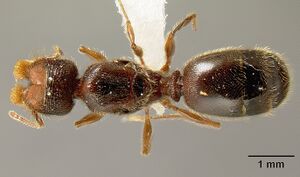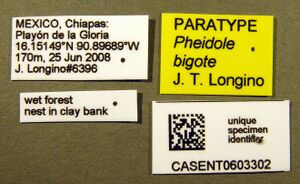Pheidole bigote
| Pheidole bigote | |
|---|---|

| |
| Scientific classification | |
| Kingdom: | Animalia |
| Phylum: | Arthropoda |
| Class: | Insecta |
| Order: | Hymenoptera |
| Family: | Formicidae |
| Subfamily: | Myrmicinae |
| Tribe: | Attini |
| Genus: | Pheidole |
| Species: | P. bigote |
| Binomial name | |
| Pheidole bigote Longino, 2009 | |
Pheidole bigote possesses morphologically intriguing major workers.
Identification
Longino (2009) - With the morphometric profile and general habitus of Pheidole fossimandibula and Pheidole vestita. Minor worker: transverse carina on anterior pronotum developed as a prominent flange visible in side view versus small (fossimandibula, vestita); mandible with basal portion roughened versus completely smooth and shining (vestita); side of propodeum only faintly foveolate and lacking rugulae versus with irregular rugulae overlaying foveolate sculpture (fossimandibula, vestita). Major worker: dorsal surface of mandible flat to weakly convex versus with broad concavity covering basal half of dorsal surface (fossimandibula); clypeus with large setal tufts in the form of pompons versus smooth and flat (vestita) or with weak gibbosities (fossimandibula), setae sparse to abundant but not in form of pompons (fossimandibula, vestita); face between frontal carinae with large hemispherical concavity versus simple, typically convex (fossimandibula, vestita).
Pheidole bigote, P. fossimandibula, and P. vestita form a trio of species that are closely similar in most characters but show remarkable divergence and diversification in the anterior head of the major worker. The minor workers of the three species are very similar and hard to differentiate. For many years the minor workers of P. fossimandibula were misidentified as P. vestita, until nests with major workers of P. fossimandibula were discovered. The major workers of the three species are very similar in shape, pilosity, and sculpture of the metasoma, mesosoma, and posterior head, in the form of the antennal scrobes and hypostomal teeth. Pheidole vestita is the least derived of the group, with smooth convex mandibles and typical clypeus and face. The other two each have their own unique derived features. Pheidole fossimandibula has a deep concavity on the dorsal surface of the mandible, a character so far unprecedented in the genus. Pheidole bigote has the dorsal surface of the mandible somewhat flattened, not as convex as P. vestita, but not at all concave, and thus intermediate between P. vestita and P. fossimandibula. Pheidole bigote has the clypeal pompons and the dish-like face excavation, characters also unprecedented in the genus. Pheidole fossimandibula has clypeal gibbosities and a brush of yellow setae on the anterior face and clypeus, perhaps an intermediate condition from which the pompons of P. bigote evolved. The face excavation of P. bigote shows no trace of similar development in P. vestita or P. fossimandibula.
Distribution
Chiapas, Mexico and Izabal, Guatemala
Latitudinal Distribution Pattern
Latitudinal Range: 16.159° to 16.15149°.
| North Temperate |
North Subtropical |
Tropical | South Subtropical |
South Temperate |
- Source: AntMaps
Distribution based on Regional Taxon Lists
Neotropical Region: Guatemala, Mexico (type locality).
Distribution based on AntMaps
Distribution based on AntWeb specimens
Check data from AntWeb
Countries Occupied
| Number of countries occupied by this species based on AntWiki Regional Taxon Lists. In general, fewer countries occupied indicates a narrower range, while more countries indicates a more widespread species. |

|
Estimated Abundance
| Relative abundance based on number of AntMaps records per species (this species within the purple bar). Fewer records (to the left) indicates a less abundant/encountered species while more records (to the right) indicates more abundant/encountered species. |

|
Biology
Longino (2009) - This species is known from a single nest excavation and a few minor workers at a bait at one lowland rainforest site in Chiapas, Mexico. The nest was in a clay bank at the edge of a small stream. The clay was stiff and highly plastic, like modeling clay, and could be carved out in slices with a pocket knife. The nest was low on the bank, close to the water level, and would undoubtedly be periodically inundated. The entrance was discovered by following workers from a cookie bait. There were three unadorned small entrance holes leading to some chambers just under the surface of the bank. These were followed by a regular series of five chambers at descending levels, slanting into the bank. The chambers were horizontal, with flat floors and ceilings, and connected by narrow slanting tunnels. Minor workers, major workers, and brood were found in most chambers, and the lowest chamber contained a single colony queen. The lowest chamber was 12cm beneath the surface. No seeds were found in the chambers.
The nest was discovered while baiting workers at night, but minor workers were also taken at a bait during the day.
A sample of minor workers, major workers, and brood were kept alive for a few days in a petri dish with some clay from the nest excavation site. No special behavior of the major workers was observed; the ants simply remained clustered with the brood and somewhat inactive. The bizarre features of the major worker of this species demand further investigation of their function.
Castes
Worker
Minor
Images from AntWeb
   
| |
| Paratype Pheidole bigote. Worker. Specimen code casent0608824. Photographer Erin Prado, uploaded by California Academy of Sciences. | Owned by CAS. |
    
| |
| Paratype Pheidole bigote. Worker. Specimen code jtlc000014969. Photographer S. Bylsma, uploaded by California Academy of Sciences. | Owned by UNAM. |
   
| |
| Paratype Pheidole bigote. Worker. Specimen code jtlc000014973. Photographer Stephanie Ware, uploaded by Field Museum. | Owned by FMNH. |
Major
Images from AntWeb
   
| |
| Paratype Pheidole bigote. Worker (major/soldier). Specimen code casent0608810. Photographer Erin Prado, uploaded by California Academy of Sciences. | Owned by CAS. |
Queen
Images from AntWeb
   
| |
| Paratype Pheidole bigote. Queen (alate/dealate). Specimen code casent0603302. Photographer J. Russ, uploaded by California Academy of Sciences. | Owned by JTLC. |
Nomenclature
The following information is derived from Barry Bolton's Online Catalogue of the Ants of the World.
- bigote. Pheidole bigote Longino, 2009: 13, fig. 1 (s.w.) MEXICO.
Unless otherwise noted the text for the remainder of this section is reported from the publication that includes the original description.
Description
Worker
Minor
Measurements (paratype): HL 0.64, HW 0.60, HLA 0.22, SL 0.57, EL 0.14, ML 0.79, PSL 0.01, PMG 0.00, SPL 0.03, PTW 0.11, PPW 0.14, CI 93, SI 95, PSLI 2, PMGI 0, SPLI 5, PPI 130.
Measurements (n=4): HL 0.64–0.69, HW 0.60–0.63, SL 0.57–0.60, CI 89–93, SI 95–99.
Mandible with faint rugulose-foveolate sculpture on base of dorsal surface, grading to smooth and shiny at masticatory margin; clypeus smooth and shining; face with about four widely-spaced concentric rugae around antennal insertion and a few longitudinal rugulae medial to compound eye, a few indistinct, arcuate carinulae on posterior face, otherwise face smooth and shining; posterior margin of vertex rounded; occipital carina narrow, visible in full face view; scape faintly foveolate, with abundant erect setae longer than maximum width of scape; promesonotum smoothly arched with no trace of promesonotal groove; anterior pronotum with a transverse carina that is elevated, flange-like, and distinctly visible as an anterior lip in lateral view; propodeal spines very short, upturned; promesonotum smooth and shining; katepisternum and lateral and dorsal faces of propodeum foveolate with overlying irregular rugulae; abundant setae on promesonotal dorsum; dorsal (outer) margin of hind tibia with abundant suberect setae longer than maximum width of tibia; first gastral tergum smooth and shining; gastral dorsum with moderately abundant, long erect setae; color dark red brown.
Major
Measurements (holotype): HL 1.73, HW 1.36, HLA 0.41, SL 0.61, EL 0.22, ML 1.41, PSL 0.05, PMG 0.00, SPL 0.07, PTW 0.29, PPW 0.49, IHT 0.25, OHT 0.54, CI 79, SI 45, PSLI 3, PMGI 0, SPLI 4, PPI 168, HTI 45.
Measurements (n=4): HL 1.67–1.73, HW 1.31–1.36, SL 0.61–0.63, CI 78–79, SI 45–47.
Mandible smooth and shining, somewhat flattened dorsally, with abundant piligerous puncta and an even covering of long decumbent yellow setae; clypeus with two large, horn-like gibbosities, but these covered from view by prominent tufts of yellow setae that are erect at base, densely clustered on gibbosities like sheaves of wheat, and then curve and become matted distally, forming globose pompons; frontal carinae slanting obliquely outward posteriorly, forming dorsal margins of prominent antennal scrobes, ventral margin of scrobe not sharply defined; scrobe, side of head, and vertex lobes coarsely reticulate rugose; area between frontal carinae and entire middle of face with a deep hemispherical concavity; anterior portion of concavity with dense layer of minute piligerous puncta from which arises a dense, short, yellow pubescence; posterior portion of concavity grading into regular concentric rugae with somewhat longer pubescence; rim of concavity with long, whisker-like setae laterally and posteriorly, basket-like; rest of face and sides of head with abundant erect setae; scape microsculptured and dull, not shining, terete at base, with abundant erect setae longer than maximum width of scape; hypostomal margin straight; median tooth small; inner hypostomal teeth pointed, stout, about one half distance from midline to outer hypostomal teeth; promesonotal groove absent; propodeal spines present; pronotum with reticulate rugae on humerus, sparse transverse carinulae anterolaterally, otherwise generally smooth and shining; rest of mesosoma generally shining, with some irregular rugulae and foveolae; dorsal (outer) margin of hind tibia with abundant suberect setae longer than maximum width of tibia; pilosity abundant on mesosomal dorsum; postpetiole in dorsal view strongly lenticular, much broader than long; first gastral tergite with small patch of longitudinal etched microsculpture near postpetiolar insertion, smooth and shining elsewhere, with abundant long erect yellowish setae; color dark red brown.
Type Material
Holotype major worker. Mexico, Chiapas: Playón de la Gloria, 16.15149°N 90.89689°W, ±16m, 170m, 25 Jun 2008 (J. Longino#6396) [UNAM, unique specimen identifier CASENT0603300].
Paratypes: major and minor workers. Same data as holotype The Natural History Museum, California Academy of Sciences, EAPZ, ECOSCE, Field Museum of Natural History, Instituto Nacional de Biodiversidad, John T. Longino Collection, Los Angeles County Museum of Natural History, Museum of Comparative Zoology, Musee d'Histoire Naturelle Genève, Instituto de Zoologia Agricola, Museu de Zoologia da Universidade de Sao Paulo, MEL, UCD, UNAM, ICN, National Museum of Natural History, UVGC.
Etymology
The name is in reference to the large "bigote" (mustache in Spanish) that projects from the clypeus.
References
- Longino, J.T. 2009. Additions to the taxonomy of New World Pheidole. Zootaxa 2181: 1-90. PDF
References based on Global Ant Biodiversity Informatics
- Longino J. T. 2009. Additions to the taxonomy of New World Pheidole (Hymenoptera: Formicidae). Zootaxa 2181: 1-90.
- Vásquez-Bolaños M. 2011. Lista de especies de hormigas (Hymenoptera: Formicidae) para México. Dugesiana 18: 95-133

